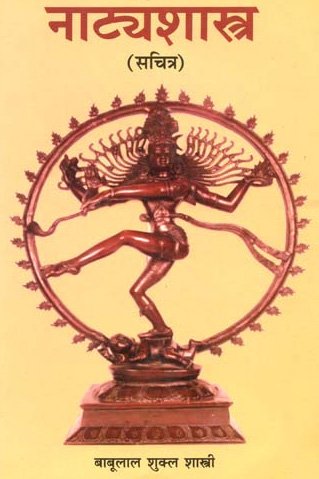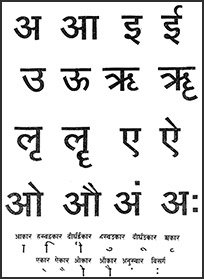Parivartana: 16 definitions
Introduction:
Parivartana means something in Hinduism, Sanskrit, Jainism, Prakrit, Hindi. If you want to know the exact meaning, history, etymology or English translation of this term then check out the descriptions on this page. Add your comment or reference to a book if you want to contribute to this summary article.
Alternative spellings of this word include Parivartan.
In Hinduism
Natyashastra (theatrics and dramaturgy)
Source: Wisdom Library: Nāṭya-śāstraParivartana (परिवर्तन) refers to one of the ten practices performed after the removal of the stage curtain, according to the Nāṭyaśāstra chapter 5. Accordingly, “The Walking-round (parivartana) is so styled because in it, the guardian deities of different worlds are praised [by the Director] walking all over [the stage].”.
Performing the parivartana preliminary pleases the Lokapālas. According to Nāṭyaśāstra 5.57-58, “The performance of the Preliminaries which means worshipping (pūjā) the gods (devas), is praised by them (i.e. gods) and is conducive to duty, fame and long life. And this performance whether with or without songs, is meant for pleasing the Daityas and the Dānavas as well as the gods.”

Natyashastra (नाट्यशास्त्र, nāṭyaśāstra) refers to both the ancient Indian tradition (shastra) of performing arts, (natya—theatrics, drama, dance, music), as well as the name of a Sanskrit work dealing with these subjects. It also teaches the rules for composing Dramatic plays (nataka), construction and performance of Theater, and Poetic works (kavya).
Vyakarana (Sanskrit grammar)
Source: Wikisource: A dictionary of Sanskrit grammarParivartana (परिवर्तन).—Reversion in the order of words as found in the recital of the Veda at the time of the recital of जटा, घन (jaṭā, ghana) and other artificial types of recitations.

Vyakarana (व्याकरण, vyākaraṇa) refers to Sanskrit grammar and represents one of the six additional sciences (vedanga) to be studied along with the Vedas. Vyakarana concerns itself with the rules of Sanskrit grammar and linguistic analysis in order to establish the correct context of words and sentences.
Ayurveda (science of life)
Source: gurumukhi.ru: Ayurveda glossary of termsParivartana (परिवर्तन):—Eversion

Āyurveda (आयुर्वेद, ayurveda) is a branch of Indian science dealing with medicine, herbalism, taxology, anatomy, surgery, alchemy and related topics. Traditional practice of Āyurveda in ancient India dates back to at least the first millenium BC. Literature is commonly written in Sanskrit using various poetic metres.
Shaktism (Shakta philosophy)
Source: Google books: Genesis and Development of Tantra (Shaktism)Parivartana (परिवर्तन) refers to “changing (one’s form)”, according to the Siddhayogeśvarīmata: an ancient Sanskrit text devoted to cults of Goddesses as the Vidyāpīṭha or Vidyā Corpus.—Although Vedic rituals were a reliable way for the people of ancient India to fulfill their objectives, Tantric rites too claim to bring about the attainment of wishes. [...] In the Siddhayogeśvarīmata, the objectives of the rites are classified as siddhis [e.g., twelve kinds of black magic (abhicāras) such as changing one’s form (rūpasya parivartanam)]. They belong to the category of supernatural phenomena and seem to be considerably different from the types of wish people expected to gain from the Vedic rituals that still remained within the sphere of everyday life.

Shakta (शाक्त, śākta) or Shaktism (śāktism) represents a tradition of Hinduism where the Goddess (Devi) is revered and worshipped. Shakta literature includes a range of scriptures, including various Agamas and Tantras, although its roots may be traced back to the Vedas.
In Jainism
General definition (in Jainism)
Source: Encyclopedia of Jainism: Tattvartha Sutra 2: the Category of the livingParivartana (परिवर्तन, “whirling around”) or Parāvartana.—An auspicious living being becomes eligible to attain the subsidential right faith when half the time of whirling around matter (parivartana) remains. How many types of ‘whirling around matter’ (parivartana) are there and which are they? These are five in number, namely: substance, place, time, state /realm and disposition/ mode. How many subtypes are there of substance parivartana? Karma and nokarma are the two types of substance parivartana.

Jainism is an Indian religion of Dharma whose doctrine revolves around harmlessness (ahimsa) towards every living being. The two major branches (Digambara and Svetambara) of Jainism stimulate self-control (or, shramana, ‘self-reliance’) and spiritual development through a path of peace for the soul to progess to the ultimate goal.
Languages of India and abroad
Sanskrit dictionary
Source: DDSA: The practical Sanskrit-English dictionaryParivartana (परिवर्तन).—
1) Moving to and fro, turning about, rolling about (as on the lap, bed &c.); महार्हशय्या- परिवर्तनच्युतैः स्वकेशपुष्पैरपि या स्म दूयते (mahārhaśayyā- parivartanacyutaiḥ svakeśapuṣpairapi yā sma dūyate) Kumārasambhava 5.12; R.9.13; Śiśupālavadha 4.47.
2) Turning round, revolving, whirling round.
3) Revolution, end of a period or time.
4) Change; वेषपरिवर्तनं विधाय (veṣaparivartanaṃ vidhāya) Pañcatantra (Bombay) 3.
5) Exchange, barter......परि- हापणमुपभोगः परिवर्तनमपहारश्चेति कोशक्षयः (pari- hāpaṇamupabhogaḥ parivartanamapahāraśceti kośakṣayaḥ) Kau. A.2.7.26. also राजद्रव्याणामन्यद्रव्येणादानं परिवर्तनम् (rājadravyāṇāmanyadravyeṇādānaṃ parivartanam)
6) Inverting.
7) Requital, return.
Derivable forms: parivartanam (परिवर्तनम्).
Source: Cologne Digital Sanskrit Dictionaries: Edgerton Buddhist Hybrid Sanskrit DictionaryParivartana (परिवर्तन).—(nt.? to Sanskrit parivartati; not recorded precisely in this sense), turning-place, place of habitual movement, in golāṅgula-p°, q.v.
Source: Cologne Digital Sanskrit Dictionaries: Benfey Sanskrit-English DictionaryParivartana (परिवर्तन).—[pari-vartana], i. e. pari-vṛt + ana, I. adj., f. nī, Causing to turn, [Kathāsaritsāgara, (ed. Brockhaus.)] 46, 118. Ii. n. 1. Turning. 2. Moving to and fro, [Pañcatantra] 188, 10. 3. Revolution, the end of a period, Mahābhārata 1, 1254. 4. Exchange, barter, [Kathāsaritsāgara, (ed. Brockhaus.)] 12, 50.
Source: Cologne Digital Sanskrit Dictionaries: Cappeller Sanskrit-English DictionaryParivartana (परिवर्तन).—[feminine] ī = [preceding] [adjective]; [neuter] turning round, revolving; revolution, lapse or end (of time), change, barter.
Source: Cologne Digital Sanskrit Dictionaries: Monier-Williams Sanskrit-English Dictionary1) Parivartana (परिवर्तन):—[=pari-vartana] [from pari-vṛt] mf(ī)n. causing to turn round
2) [=pari-vartana] [from pari-vṛt] n. turning or whirling round, moving to and fro (trans. and intrans.), [Kāvya literature; Suśruta; Pañcatantra; Bhāgavata-purāṇa]
3) [v.s. ...] rolling about or wallowing on ([compound]), [Kālidāsa]
4) [v.s. ...] revolution, end of a period of time, [Mahābhārata; Harivaṃśa]
5) [v.s. ...] barter, exchange, [Kathāsaritsāgara; Pañcatantra; Mṛcchakaṭikā]
6) [v.s. ...] cutting or clipping the hair, [Śatapatha-brāhmaṇa]
7) [v.s. ...] protecting, defending, [Nalacampū or damayantīkathā]
8) [v.s. ...] = preraṇa, [Taittirīya-brāhmaṇa [Scholiast or Commentator]]
9) [v.s. ...] inverting, taking or putting anything in a wrong direction, [Horace H. Wilson]
10) [v.s. ...] requital, return, [ib.]
Source: DDSA: Paia-sadda-mahannavo; a comprehensive Prakrit Hindi dictionary (S)Parivartana (परिवर्तन) in the Sanskrit language is related to the Prakrit words: Pariaṭṭaṇa, Pariaṭṭaṇā, Parivaṭṭaṇa.
[Sanskrit to German]
Sanskrit, also spelled संस्कृतम् (saṃskṛtam), is an ancient language of India commonly seen as the grandmother of the Indo-European language family (even English!). Closely allied with Prakrit and Pali, Sanskrit is more exhaustive in both grammar and terms and has the most extensive collection of literature in the world, greatly surpassing its sister-languages Greek and Latin.
Hindi dictionary
Source: DDSA: A practical Hindi-English dictionaryParivartana (परिवर्तन) [Also spelled parivartan]:—(nm) change; alteration; variation; interchange; ~[vartanavādī] radical, supporting constant change; ~[vartanīya] changeable; alterable; variable; interchangeable; ~[vartita] changed, altered; undergone variation; interchanged; ~[vartitā] variability; changeability.
...
Kannada-English dictionary
Source: Alar: Kannada-English corpusParivartana (ಪರಿವರ್ತನ):—
1) [noun] a goind round.
2) [noun] a moving to and fro; to wander.
3) [noun] the periodical destruction of the world.
4) [noun] a giving or taking of one thing for another; an exchange.
5) [noun] the act, fact or process of changing or being changed; an instance of this; a change.
6) [noun] a deviating from what is natural, right or correct.
7) [noun] (jain.) the mutable, changeable world or worldly life.
8) [noun] a device for commutating an electric current; a commutator.
Kannada is a Dravidian language (as opposed to the Indo-European language family) mainly spoken in the southwestern region of India.
Nepali dictionary
Source: unoes: Nepali-English DictionaryParivartana (परिवर्तन):—n. 1. change; 2. exchange (of object) conversion (of currency); 3. transformation;
Nepali is the primary language of the Nepalese people counting almost 20 million native speakers. The country of Nepal is situated in the Himalaya mountain range to the north of India.
See also (Relevant definitions)
Partial matches: Vartana, Pari.
Starts with: Parivartanagollu, Parivartanakala, Parivartanakarana, Parivartanashila, Parivartanavada, Parivartanavadi.
Ends with (+5): Angaparivartana, Ankaparivartana, Anuparivartana, Aparivartana, Ardhapudgalaparivartana, Arthaparivartana, Bhautika-parivartana, Cakraparivartana, Dharmaparivartana, Dishaparivartana, Golangulaparivartana, Goligulaparivartana, Kalaparivartana, Kramaparivartana, Mukta-parivartana, Parshvaparivartana, Rasayanika-parivartana, Samparivartana, Samsaraparivartana, Shasana-parivartana.
Full-text (+22): Pariattana, Parivattana, Parivarta, Parivartan, Parivartani, Parshvaparivartana, Rasayanika-parivartana, Samparivartana, Vyutkramana, Parivatti, Vaakya-parivartan, Changing, Goligulaparivartana, Viparivartana, Parshvaikadashi, Viparivartita, Amula, Ankaparivartana, Viparivartitadhara, Samsaraparivartana.
Relevant text
Search found 12 books and stories containing Parivartana, Pari-vartana, Parivartanā; (plurals include: Parivartanas, vartanas, Parivartanās). You can also click to the full overview containing English textual excerpts. Below are direct links for the most relevant articles:
Alamkaras mentioned by Vamana (by Pratim Bhattacharya)
16: Definition of Parivṛtti Alaṃkāra < [Chapter 4 - Arthālaṃkāras mentioned by Vāmana]
Gati in Theory and Practice (by Dr. Sujatha Mohan)
Gati performed in Lāsyāṅgas < [Chapter 3 - Application of gati in Dṛśya-kāvyas]
Gati performed in Pūrvaraṅga < [Chapter 3 - Application of gati in Dṛśya-kāvyas]
Sanskrit sources of Kerala history (by Suma Parappattoli)
1.1. The Raksapurusaka by Krishnachandra < [Chapter 5 - Sanskrit Dramas and Campus bearing on Kerala History]
Tattvartha Sutra (with commentary) (by Vijay K. Jain)
Verse 3.28 - The nature of the other regions < [Chapter 3 - The Lower World and the Middle World]
Verse 2.3 - Two kinds of subsidential disposition (aupaśamika-bhāva) < [Chapter 2 - Category of the Living]
Verse 2.10 - Two classifications of souls < [Chapter 2 - Category of the Living]
Jainism and Patanjali Yoga (Comparative Study) (by Deepak bagadia)
Part 8 - Celebrations/ Festivals, Prayers and Prime symbol in Jain traditions < [Chapter 3 - Jain Philosophy and Practice]
Dharmadhyana (virtuous or righteous meditation) < [Chapter 3 - Jain Philosophy and Practice]
Part 7 - Patanjali’s Ashtanga Yoga compared to Jainism < [Chapter 4 - A Comparative Study]
Dasarupaka (critical study) (by Anuru Ranjan Mishra)
Part 11 - Technical Aspects of a Prakaraṇa < [Chapter 10 - Prakaraṇa (critical study)]